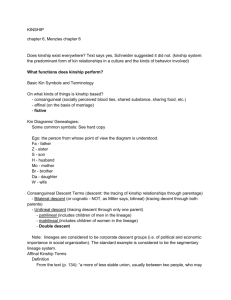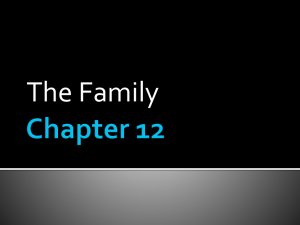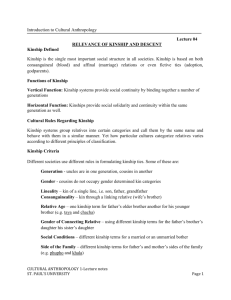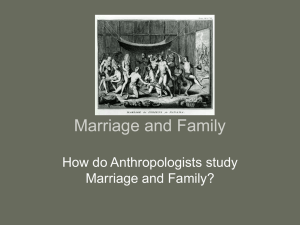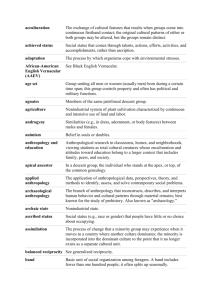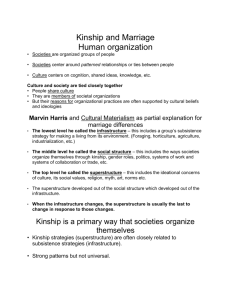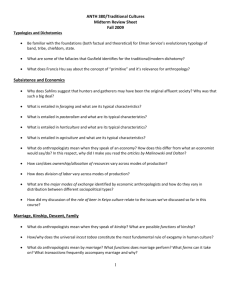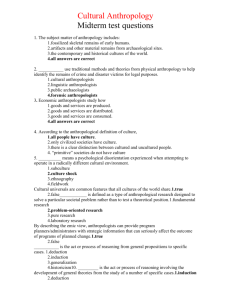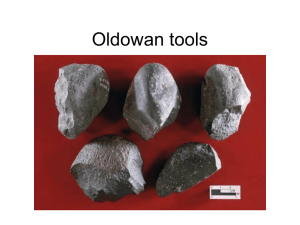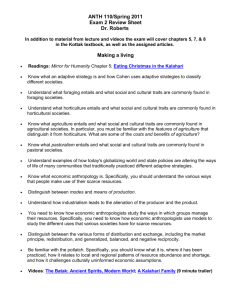relevance of kinship and descent
advertisement
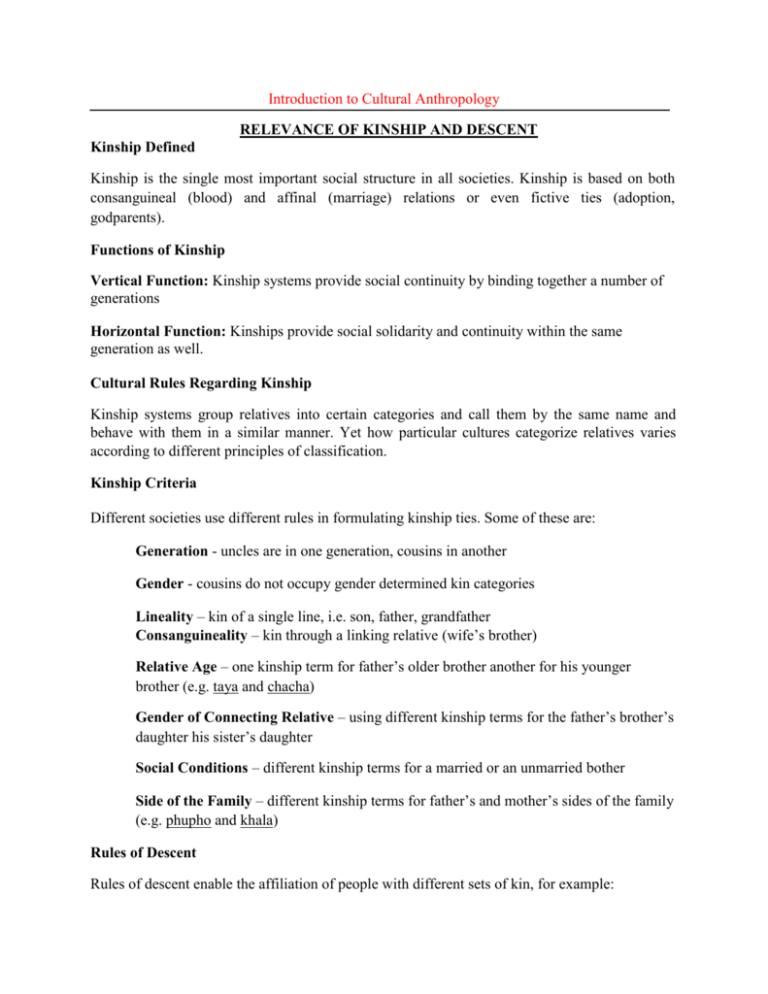
Introduction to Cultural Anthropology RELEVANCE OF KINSHIP AND DESCENT Kinship Defined Kinship is the single most important social structure in all societies. Kinship is based on both consanguineal (blood) and affinal (marriage) relations or even fictive ties (adoption, godparents). Functions of Kinship Vertical Function: Kinship systems provide social continuity by binding together a number of generations Horizontal Function: Kinships provide social solidarity and continuity within the same generation as well. Cultural Rules Regarding Kinship Kinship systems group relatives into certain categories and call them by the same name and behave with them in a similar manner. Yet how particular cultures categorize relatives varies according to different principles of classification. Kinship Criteria Different societies use different rules in formulating kinship ties. Some of these are: Generation - uncles are in one generation, cousins in another Gender - cousins do not occupy gender determined kin categories Lineality – kin of a single line, i.e. son, father, grandfather Consanguineality – kin through a linking relative (wife’s brother) Relative Age – one kinship term for father’s older brother another for his younger brother (e.g. taya and chacha) Gender of Connecting Relative – using different kinship terms for the father’s brother’s daughter his sister’s daughter Social Conditions – different kinship terms for a married or an unmarried bother Side of the Family – different kinship terms for father’s and mother’s sides of the family (e.g. phupho and khala) Rules of Descent Rules of descent enable the affiliation of people with different sets of kin, for example: Patrilineal descent affiliates a person with the kin of the father Matrilineal descent affiliates a person with the kin of the mother Ambilineal descent permits an individual to affiliate with either parent’s kin group Consanguineal versus Affinal Kin Some societies make a distinction in kinship categories based on whether people are related by blood (consanguineal kin) or through marriage (affinal kin). For example, take the difference between a sister and a sister-in-law or a brother and a brother-in-law. Comparing Descent Groups Patrilineal descent groups are most common around the world. The relations between man and wife tend to be more fragile in matrilineal societies. Useful Terms Unilineal descent: tracing descent through a single line (such as matrilineal or patrilineal) as compared to both sides (bilateral decent|) Bilateral: able to accommodate two-sides simultaneously Matrineally: mother’s side of the family Patrineally: father’s side of the family Prevalent: common amongst many Kinship: relationship Merging: integration Suggested Readings Students are advised to read the following chapters to develop a better understanding of the various principals highlighted in this hand-out: Chapter 10 in ‘Cultural Anthropology: An Applied Perspective’ by Ferrarro and/or Chapter 21 in ‘Anthropology’ by Ember and Pergrine Tracing Descent In societies that trace their descent unilineally, people recognize that they belong to a particular unilineal descent group or series of groups. Sixty percent of cultures in the world are unilineal. Unilineal groups are adaptive and clear-cut social units, based on birthright, which in turn influence inheritance, marriage and prestige issues Kinship Organization Kinship is organized on the basis of different groups of varying sizes: Lineages are based on a set of kin who can trace their ancestry back through known links Clans are unilineal groups which claim descent but they are unable to trace all their genealogical links Phratries are groups of related clan Moieties are two halves of a society related by descent Bilateral Descent A person is related equally to both sides of the family on the basis of bilateral descent. This form of descent is prevalent in foraging and industrialized societies. Bilateral systems are symmetrical and result in the formation of kindred, which are loose kinship networks rather than being permanent corporate functioning groups. Double Descent A double unilineal descent system is one where descendents are traced matrineally and patrineally. As a result, both sides of the family have a useful social function such as enabling inheritance. Under this system, it is possible for moveable property such as livestock or agricultural produce to be inherited from the mother’s side, whereas non-moveable property (land) may be inherited from the father’s side. This system is found in only 5% of world cultures (for e.g. the Yako in Nigeria). Primary Kinship Systems There are six basic types of kinship systems used to define how cultures distinguish between different categories of relatives. Eskimo are found in one-tenth of the world societies, this system involves bilateral descent, focusing on nuclear relations and lumping external relatives (cousins, uncles and aunts). Hawaiian are found in a third of world societies, this system uses the same term for all relatives of the same gender and generation, so the term mother is used not only for the mother but also for her sisters and the father’s sisters. Cousins are termed brothers and sisters. This is an ambivalent system, which submerges the nuclear family into a larger kinship group. Iroquois are a less prevalent system which emphasizes the importance of unilineal descent groups by distinguishing between members of one’s own lineage and those belonging to other lineages. Sudanese are the system is named after the country where the system was first identified. It is the most pluralistic system since it makes the most terminological distinctions. Omaha emphasizes patrilineal descent, the father and his brothers are referred to by the same term and the paternal cousins are called siblings, but cross cousins are referred to by separate terms. On the mother’s side there is a merging of generations, all her male relatives are called mother’s brother. Crow is the exact opposite of the Omaha system, as it emphasizes maternal relations which are all important for determining the descent group of children. Kinship Diagrams Cultural Anthropologists often use kinship diagrams to help explain family structures, which use simple symbols for males and females, and to indicate what their relationships are to each other. The diagram below depicts a married couple and their two children (a son and a daughter): Useful Terms Descent: established linage Ambivalent: unclear Influence: power Social function: the particular purpose served for society Prestige: Social honor or respect within a society Suggested Readings Students are advised to read the following chapters to develop a better understanding of the various principals highlighted in this hand-out: Chapter 10 in ‘Cultural Anthropology: An Applied Perspective’ by Ferrarro and/or Chapter 21 in ‘Anthropology’ by Ember and Pergrine THE ROLE OF FAMILY AND MARRIAGE IN CULTURE Family and Marriage The family is a social unit in which its members cooperate economically, manage reproduction and child rearing, and most often live together. Families can be based on lineage and marital ties. Marriage, the process by which families are formed, is a socially approved union between male and female adults. Marriage is based on the assumption that it is a permanent contract. Yet there is a discrepancy between real and expected behavior within marriages, given the high rates of divorce in many countries of the modern world. Functions of Families Families reduce competition for spouses. They also regulate the division of labor on the basis of gender. Families also meet the material, educational and emotional needs of children. Marriage Restrictions Cultures restrict the choice of marriage patterns by exogamy, which means marrying outside a given group. Endogamy on the other hand implies marrying within a given group. Conservative Hindus are mostly endogamous, as are Rwandans in Central African. It is important to note that endogamous groupings can be based on lineage or even ethnic or economic similarities. Moreover, it is possible to simultaneously have an endogamous marriage (within an ethic group) that is also exogamous (outside one’s lineage). Types of Marriage Monogamy: a marriage arrangement that implies having one spouse at one time. Polygamy: a marriage arrangement that implies a man marrying more than one woman at one time. Polyandry: a marriage arrangement that implies a woman marrying more than one husband at one time. Economic Aspect of Marriage Marriages involve transfer of some type of economic consideration in exchange for rights of union, legal rights over children and rights to each other’s property. There are many cultures in the world which consider marriage as more than a union of man and wife but instead an alliance between two families. Types of Marriage Transactions Bride-wealth: transfer of wealth from a groom’s family to that of the bride’s (approximately 47%). Bride service: labor in exchange for a wife, common in small scale societies, lacking material wealth (approximately 17%). Dowry: transfer of wealth from a bride’s family to that of the groom’s. This practice was popular in medieval Europe and may still prevail in several parts of Northern India (approximately 3%). Woman Exchange: two men exchanging sister’s as wives. This practice is limited to a small number of societies (approximately 3%) in Africa and the Pacific region. Reciprocal Exchange: a roughly equal exchange of gifts between bride and groom families. Found amongst traditional Native Americans and islands in the Pacific region (approximately 6%). (Note: These above statistics are not very recent and should not be taken literally but rather as an indication of the popularity of the above types of transactions). Useful Terms Discrepancy: difference Reciprocal: equal Groom: husband Reproduction: process of giving birth to children Transaction: exchange Suggested Readings Students are advised to read the following chapters to develop a better understanding of the various principals highlighted in this hand-out: Chapter 9 in ‘Cultural Anthropology: An Applied Perspective’ by Ferrarro and/or Chapter 20 in ‘Anthropology’ by Ember and Pergrine Residence Patterns Residence patterns are influenced by kinship systems. For e.g. patrilocal residence is common in patrilineal cultures. Residence patterns can be disrupted due to events such as droughts, famines, wars or even due to economic hardship. The most common types of residence patterns evidenced around the world are: Patrilocal: the couple can live with or near the relatives of the husband’s father (most prevalent) Matrilocal: the couple can live with or near the relatives of the wife’s father A nculocal: the couple can live with or near the husband’s mother’s brother Ambilocal or bilocal: the couple can live with or near the relatives of either the wife or the husband Neolocal: Where economic circumstances permit, the couple can also establish a completely new residence of their own. Residence patterns are not static. The Great Depression in America, during the 1930s, for example compelled neolocal residents to shift back to living with one of their parents again due to economic reasons. Similar circumstances keep recurring in different societies of the world and result in changing residence patterns. In many traditional societies, joint-family systems are also very common. The dynamics of a joint-family system differ from widely from living independently, implying a shared responsibility for household responsibilities, often under the charge of the oldest member of the household. Family Structures Cultural Anthropologists distinguish between two types of family structures: the nuclear family and the extended family. Nuclear families are based on marital ties, whereas the extended family is a much larger social unit, based on blood ties among three or more generations. Nuclear Family A two generation family formed around the marital union. While a part of bigger family structures, nuclear families remain autonomous and independent. Nuclear families are often found in societies with greatest amount of geographic mobility. Nuclear family patterns were encouraged by industrialization and technology but also have remained evident in foraging societies. Where resources are scare, it makes sense for people to remain in nuclear families, whereby retaining a certain level of mobility, independence. Nuclear families are therefore called the basic food collecting unit in addition to being the most dominant mode of family life in many modern-day families around the world. Extended Families Blood ties are more important than ties of marriage, which form the basis of extended families. Extended families can be matrilineal or patrilineal. The Anthropological Atlas of 1967 noted 46% out of 862 societies as having some form of extended family organization. These numbers have no doubt increased over the past few decades, given the increasing world population. Modern-Day Families Modernization and urbanization have seen progressive movement towards nuclear family structures. In developing countries, this correlation is not necessary. The lack of employment security makes extended families serve as social safety nets. Migrant families also hold onto traditional family structures even after having gone to live abroad. In western societies, even nuclear families are not so common, given high divorce and separation rates. Useful Terms Prevalent: commonly found in different places Migrant: refugee Correlation: association between two entities Scarce: in short supply Evident: obvious Suggested Readings Students are advised to read the following chapters to develop a better understanding of the various principals highlighted in this hand-out: Chapter 9 in ‘Cultural Anthropology: An Applied Perspective’ by Ferrarro and/or Chapter 20 in ‘Anthropology’ by Ember and Pergrine
